Storm-hit port reopens fully for school holidays
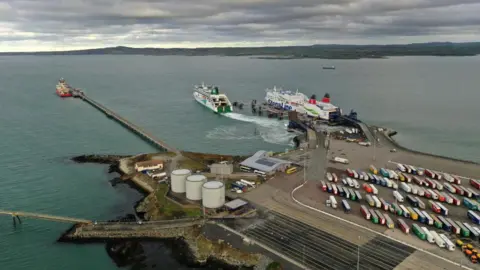 Getty Images
Getty ImagesOne of UK's busiest ports will fully reopen on Friday, seven months after a berth was shut due to damage caused by a car ferry docking during a storm.
Two berths at Holyhead, the UK's second busiest passenger port, were damaged in two separate incidents hours before the height of a rare red weather wind warning that battered Wales in December.
The port was closed for five weeks, including at Christmas and new year, as engineers fixed one of the damaged berths before Holyhead partially reopened in January and services resumed to a revised timetable.
The other berth has taken seven months to repair and reopened on Friday with the economic impact of the closures an estimated £500m in lost trade.
"It's the busiest time of year and is really important and timely," said Wales' First Minister Eluned Morgan.
It comes as schoolchildren in Wales will finish their term within the next few days while most Republic of Ireland schools have already closed for the summer.
More than 1.5m people pass through Holyhead every year making it the most popular sea route between the UK mainland and the Republic of Ireland.
Why did Holyhead Port close?
Holyhead's operators have said its closure was after successive ferries made "contact" with berthing terminals at the port just before the height of Storm Darragh in December 2024.
The incidents shut both of Holyhead's terminals because of the "interconnecting nature" of the support structures as the terminals run parallel to each other.
It blocked the busiest and shortest route between the UK mainland and Republic and Ireland over the busy Christmas and new year period.
The 40-day closure, before one berth reopened on 16 January, caused chaos for passengers and truck drivers using the four daily services of both Stena Line and Irish Ferries as people and freight had to find alternative routes over the Irish Sea.
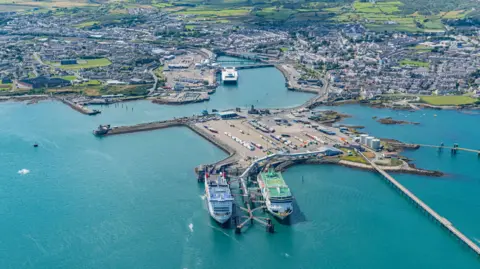 Getty Images
Getty ImagesA boss of Stena Line, which runs the port, gave evidence to a Welsh Parliament committee and said berths were designed to "take contact but very slow-speed contact".
"These contacts, maybe of a different magnitude, happen all the time," Stena's head of UK Ports Ian Davies told the Senedd's Economy and Trade Committee.
The port or ferry companies say they would not elaborate on how these specific contacts closed the port despite both the Welsh and UK governments asking.
"Those incidents are now subject to an insurance claim and I can give no further details without prejudicing that insurance claims at this time I'm afraid," Mr Davies told the UK Parliament's Welsh Affairs Committee earlier this year.
Committee chair Ruth Jones MP replied: "That is very frustrating for us but, obviously, we understand where you are coming from."
When Mr Davies was before the Welsh Parliament's economy committee, he was asked by chair Andrew RT Davies was it "not necessarily the storm caused the damage, but the actual seamanship?"
Mr Davies replied to the Senedd committee: "All we can say is there's an ongoing investigation into the actual cause, and part of that is a claim going on."
 Getty Images
Getty ImagesFerries that use Holyhead include the 50,000-tonnes Ulysses, which was the world's largest car ferry when it launched in 2000.
Holyhead's terminal five reopened on 16 January and the port has been able to operate its normal daily number of sailings - eight arrivals and eight departures.
But to accommodate that, both Irish Ferries and Stena Line had to adjust their timetables to synchronise arrivals and departures at the only operational berth.
Stena told the Senedd the damage had happened to part of terminal three, which is "predominantly" used by Irish Ferries.
Neither the port operators or the ferry companies would confirm who was taking action against whom. Both Stena Line and Irish Ferries have both declined to comment.
The berthing incidents happened during Storm Darragh - but before the red weather warning for wind kicked in at 03:00 GMT on 7 December.
According to Met Office data, three of the UK's five strongest gusts during Storm Darragh were in north Wales.
That included wind speeds of 79mph (127km/h) at Valley - about eight miles (13km) inland from Holyhead - which is the highest recorded gust on Anglesey for 27 years.
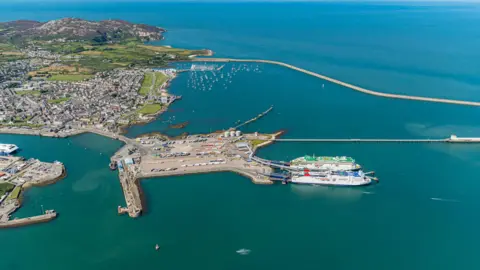 Getty Images
Getty ImagesThe Health and Safety Executive did not investigate the incidents, while the Marine Accident Investigation Branch made some "preliminary enquiries" into the "maritime aspects" of the crash.
But added in a statement: "The information gathered does not indicate any significant safety issues that would necessitate further investigation at this time."
Mr Davies said there was a "onward-going investigation" about the incidents and the port and ferry operators would review what happened once Holyhead was fully reopened.
Why has it taken so long to fully reopen Holyhead?
Seven months may seem like a long time without half of its berthing capacity but port bosses explained replacing Holyhead's damaged infrastructure was complex.
"The berths are a series of very large steel pile structures... roughly 2m (6ft 7in) in diameter and 50m (164 ft 1in) in total length and driven into the seabed," Mr Davies of Stena explained in his Senedd evidence.
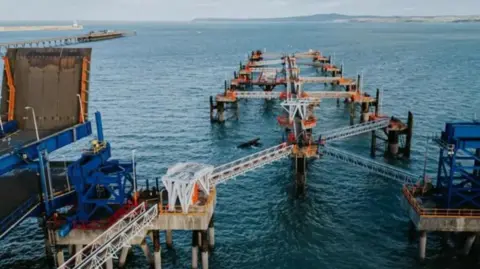 Chris Willz Photography and Film
Chris Willz Photography and FilmHe said the affected structure on terminal three "partially collapsed and had fallen at an angle" so engineers needed to charter specialist barges to get to the site and remove the fallen 120-tonne pile.
Stena needed to design, order, check and fit their new pile and its associated mechanisms.
"It was hoped we could replace the pile in the same pile socket, like replacing a false tooth, but that was not possible," added Mr Davis.
Engineers have had to drive the new pile into the sea bed and test before declaring the berth ready for passenger ferries.
"To be frank, seven months is a short amount of time," said maritime expert Dr Stavros Karamperidis.
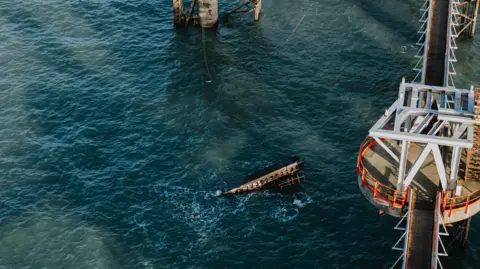 Chris Willz Photography and Film
Chris Willz Photography and Film"The analogy is having a car accident, insurance companies investigate and might offer money, the other company might dispute that and it goes back and forth.
"I'm sure the authorities have all the information but you can't give that publicly," added Dr Karamperidis, head of Plymouth University's maritime transport research group.
How important is Holyhead Port?
At just over 100 miles (161km) between Holyhead and Dublin, the three-hour and 15 minute crossing from north Wales is the quickest route between the UK mainland and the Republic of Ireland.
With more than 400,000 lorries and 400,000 cars a year using it every year, Holyhead is the second busiest passenger ferry port to Dover.
It is Wales' biggest international transport hub with almost double the amount of annual passengers of Wales' only major airport in Cardiff.
"It is one of the large corridors that connects Wales and the UK to Ireland because of the shortness and frequency of the crossing," Mr Davies told Parliament.
"It adds a dynamic, especially to the just-in-time logistics industry, which perhaps other corridors do not have. I cannot overemphasise how important it is. It is critical."
He added night ferries could create freight lorry convoys of up to three miles (5km) long, such is the strategic importance to both the UK and Republic of Ireland.
"Holyhead is a huge economic driver for us here in Ireland because so much of our exports by sea go through Holyhead into the UK," said Irish government Minister Sean Canney.
 Welsh Government
Welsh GovernmentHe said more than a third of roll-on, roll-off traffic traffic to the Republic of Ireland came through Holyhead, emphasising the importance part of another country is to his nation.
"Both countries rely on Holyhead for stuff coming in and out between the UK and Ireland, it's a huge vein across the Irish Sea," added Canney.
Experts estimate the economic impact of Holyhead Port and its supply chain in north Wales is more than £100m a year with 1,000 jobs locally relying on it.
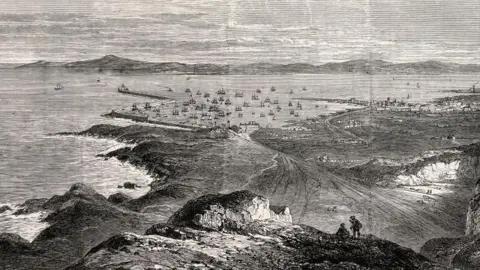 Getty Images
Getty ImagesBangor University's senior economics lecturer Edward Jones also told Parliament an "additional 1,600 to 1,700 jobs at a national level is dependent" on Holyhead.
A Senedd Committee heard in April the value of trade going through Holyhead during the complete closure was almost £500m less than the year before.
Both the Welsh and Irish government also hoped everyone involved could "learn lessons" on how they react to incidents like this.
Stena Line said: "We would like to thank our staff and delivery partners for their hard work and commitment over the last months.
"Both Terminal 3 and 5 are now in operation for the ferry operators and their customers and we appreciate their patience and support during the repair work."
